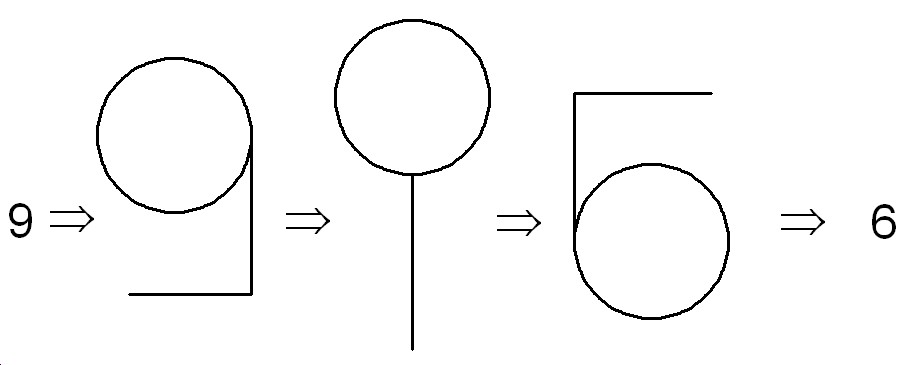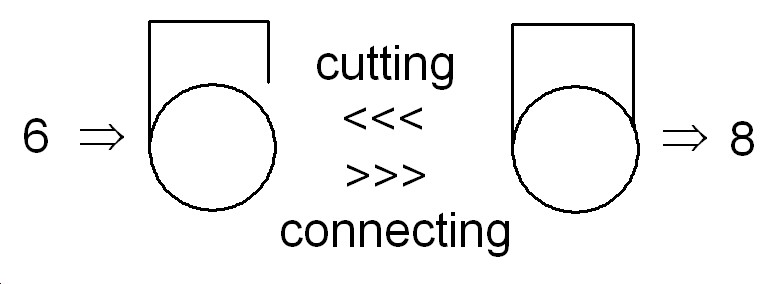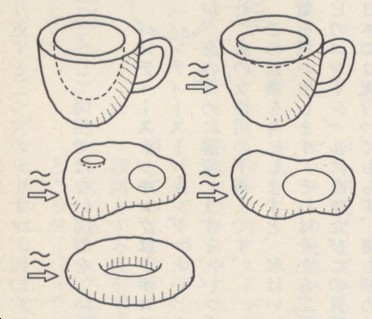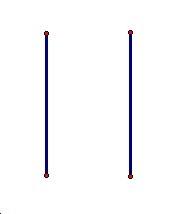
Topological Structure of Japanese Letters
Introduction of Concept of Topology
Topology is a branch of geometry that deals with specific properties of geometric shapes that stay the same, no matter how much the shapes are bent, twisted, stretched, or deformed. The only rule is that distinct points in the space cannot coincide and that "tearing" the space cannot be allowed. Topology's nickname is rubber-band geometry. Geometry is concerned with properties such as absolute position, distance, and parallel lines, but topology is more concerned with relative position and general shape.(http://jaboinga.tripod.com/mobius/topo.html)
Any two plane figures that are same if one of them can turn into the other by stretching, bending, without cutting or connecting.
In topological world, a circle and a square (in fact, any polygon) are completely same because a circle can be turned into a square without cutting part ("tearing") or putting anything, done just by streching as on a lubber-band.

Consider the numbers 6 and 9. They are topologically same. Both can be represented as one circle connected to a line.

Besides this, 6 and 8 are not the same topologically because we definitely need to cut or connect to change into each other.

It is easy to apply this idea into the three dimensional space. For example, a sphere is the same as a cube or as a tetrahedron.

We can also say a coffee cup with one hundle is topologically same as a doughnut with one hole or as a tire.

But, in this essay I mention about plane figures only.
Hiragana
I want to think of the set of Japanese letters. The letters are called "hiragana", each of wich has one sound.
Here is the all of hiragana.
|
|
|
|
|
|
|
|
|
|
|
|
|
|
|
|
|
|
|
|
|
|
|
|
|
|
|
|
|
|
|
|
|
|
|
|
|
|
|
|
|
|
|
|
|
|
|
|
|
|
|
|
|
|
|
|
|
|
|
|
|
|
|
|
|
|
It is clear that ![]() and
and![]() are
the same topologically, because both of them consist of two lines.
are
the same topologically, because both of them consist of two lines.
![]() =
= 
![]() =
= 
Can you find other letters in a group of hiragana that are
toporogically equal to ![]() and
and![]() ?
?
Group1 below is one containing all hiragana letters that have
the same structure as ![]() and
and![]() . We
may call this group "Two lines"
. We
may call this group "Two lines"
Group1 (Two lines)
![]()
![]()
![]()
![]()
![]()
![]()
Ok, let us go ahead grouping the other hiragana letters.
Group2 (One line)
![]()
![]()
![]()
![]()
![]()
![]()
![]()
![]()
![]()
It is easy to look at their similarity. They are one stroke letters.
Do you think ![]() and some
other letters do not look one stroke? Please look at this
website to see how these letters are written in a hiragana table.
and some
other letters do not look one stroke? Please look at this
website to see how these letters are written in a hiragana table. ![]() is
on the left bottom corner of the table.
is
on the left bottom corner of the table.
Group3
![]()
![]()
![]()
![]()
![]()
Group4
![]()
![]()
Group5
![]()
![]()
Group6 (+ sign)
![]()
![]()
They are synmetric as well as the same topologically. They are also the same as a + sign.
Group7 (6 or 9)
![]()
![]()
They are also the same as the numbers 6 and 9.
Group8
![]()
![]()
Group9 (16 unique letters)
![]()
![]()
![]()
![]()
![]()
![]()
![]()
![]()
![]()
![]()
![]()
![]()
![]()
![]()
![]()
![]()
Each of this group of hiragana letters does not have the letter that is the same topologically as itself. So, they are unique.
Finally, we found that there are 24 groups (8 groups and 16unique letters) of hiragana letters in the way of dividing topologically.
Next, we consider another set of Japanese letter called "katakana". Katakana letters are normally used to describe a word coming from a foreighn language.
|
|
|
|
|
|
|
|
|
|
|
|
|
|
|
|
|
|
|
|
|
|
|
|
|
|
|
|
|
|
|
|
|
|
|
|
|
|
|
|
|
|
|
|
|
|
||
|
|
|
|
|
|
|
|
|
|||
|
|
Let's do grouping katakana letters in the same way as hiragana.
Group1 (T)
![]()
![]()
![]()
![]()
![]()
![]()
![]()
![]()
![]()
![]()
![]()
They are the same as an alphabet T.
Group2 (One line)
![]()
![]()
![]()
![]()
![]()
![]()
![]()
Group3 (Two lines)
![]()
![]()
![]()
![]()
![]()
![]()
![]()
Group4 (+ sign)
![]()
![]()
![]()
![]()
![]()
![]()
Group5
![]()
![]()
Group6 (Three lines)
![]()
![]()
![]()
Group7
![]()
![]()
Group8 (8 unique letters)
![]()
![]()
![]()
![]()
![]()
![]()
![]()
![]()
Each of this group of katakana letters does not have the letter that is the same topologically as itself. So, they are unique.
Finally, we found that there are 15 groups (7 groups and 8 unique letters) of katakanaletters in the way of dividing topologically.
Hiragana and Katakana
Let's consder mixing up hiragana and katakana letters to make topological groups.
Group1 (One line)
![]()
![]()
![]()
![]()
![]()
![]()
![]()
![]()
![]()
![]()
![]()
![]()
![]()
![]()
![]()
![]()
Group2 (Two lines)
![]()
![]()
![]()
![]()
![]()
![]()
![]()
![]()
![]()
![]()
![]()
![]()
![]()
Group3 (Alphabet T)
![]()
![]()
![]()
![]()
![]()
![]()
![]()
![]()
![]()
![]()
![]()
![]()
Group4 (+ sign)
![]()
![]()
![]()
![]()
![]()
![]()
![]()
![]()
Group5
![]()
![]()
![]()
![]()
![]()
![]()
![]()
Group6 (Three lines)
![]()
![]()
![]()
![]()
Group7
![]()
![]()
Group8
![]()
![]()
Group9
![]()
![]()
Group10
![]()
![]()
Group11
![]()
![]()
Group12
![]()
![]()
Group13 (20 unique letters)
![]()
![]()
![]()
![]()
![]()
![]()
![]()
![]()
![]()
![]()
![]()
![]()
![]()
![]()
![]()
![]()
![]()
![]()
![]()
![]()
Finally, we found that there are25 groups (12 groups and 13unique letters) of hiragana letters in the way of dividing topologically.
How about English letters?
It is now to think about English letters
In the case of English, I think the way of how the letters are grouped would depend on what font we use. Here I give you a font called Arial so that you can think of it specifically.
ABCDEFGHIJKLMNOPQRSTUVWXYZ
Group1 (One line)
CGIJLMNSUVWZ
Group2 (Alphabet T)
ETYF
Group3
PQX
Group4
AR
Group5
DO
Group6
HK
Group7
B
Thus, 26 letters of alphabet are divided into 9 (6 groups and 3 unique letters) groups of the same topological structure.
The most interesting thing to me is that the Japanese "unique"
katakana ![]() and the English letter K
have the same topological structure. This is interesting fact because
and the English letter K
have the same topological structure. This is interesting fact because![]() sounds like "ke" that is similer to K!
sounds like "ke" that is similer to K!
We can also see a similarity between hiragana and alphabet in the fact that in both groups of letters, the "one line" group is the largest group. The "one line" group and "an alphabet T" group are two largest groups in both katakana and alphabet letters. May we come to conclusion that Japanese (hiragana and katakana) letters and English alphabet are similar?
There might be other interesting things in the story of topological structure of various kinds of letters. If you have your own language rather than Japanese or English, it would be a great idea to think about that letters' (or charactors') topological structure. In my mind, it would be interesting to consider Japanese Kanji (Chinese characters) with topology.
For exmaple, my name is represented in Kanji as ,
where the first two characters are my family name and the last two characters
are my given name.
,
where the first two characters are my family name and the last two characters
are my given name.
 is the same as
four of the alphabet letters,ETYFand
many of Katakana.
is the same as
four of the alphabet letters,ETYFand
many of Katakana.![]()
![]()
![]()
![]()
![]()
![]()
![]()
![]()
![]()
![]()
![]() and one Hiragana
and one Hiragana![]() .
.  is
the same as two letters D and O in
the alphabet group and one katakana
is
the same as two letters D and O in
the alphabet group and one katakana ![]() .
.
Although it seems to be interesting, it is surely complicated to include Kanji characters into our investigation because we have thousands of Kanji characters. So, here I quite my consideration of topology and language.
Here are several websites about Japanese letters.
You can see this site below to know handwriting of Hiragana,
http://japanese.about.com/blhiragana.htm
then you may understand why ![]() and
and![]() are
in the "one line" group as well as
are
in the "one line" group as well as![]() .
.
http://members.aol.com/writejapan
This site shows the stroke order, that is how people write katakana and hiragna step by step. Click the buttons, "BEGIN THE HIRAGANA TUTOR" or "BEGIN THE KATAKANA TUTOR"
http://sp.cis.iwate-u.ac.jp/sp/lesson/j/doc/kana.html (for hiragana)
http://sp.cis.iwate-u.ac.jp/cgi-bin/dictation.pl?Amode=0&Applet=syllable&Level=0&Language=Other&Display=3&Sound=0 (for katakana)
These website provides you with each sound of Hiragana and
Katakana.You click each letter, then you hear the
sound. Try ![]() in Katakana, especally.
Do you think it is similar to the sound of K?
in Katakana, especally.
Do you think it is similar to the sound of K?
In the site below, you look at the set of every Kanji charactar that Japanese 1st grade kids learn.
http://www.gahoh.marinebat.com/modules.php?name=Content&pa=showpage&pid=8
Can you find any set of Kanjis that are the same topologically?